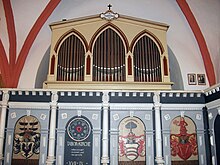Tabor Church (Hohenschönhausen)
The village church of Hohenschönhausen (Taborkirche since 1905) is the oldest building in the Berlin district of Alt-Hohenschönhausen in the Lichtenberg-Hohenschönhausen district . The building on the main street is one of the smallest village churches in Berlin .
Location and facilities
The church is located on the corner of Hauptstrasse and Wartenberger Strasse on the eastern edge of the Hohenschönhauser village center, in the middle of the old cemetery. The property is partially fenced ( field stone wall ).
The church consists of the choir in the eastern part and the nave in the western part. The sacristy joins the choir to the north. On the south side there are two extensions from 1905. In the smaller extension, the staircase to the patron's box was initially housed; meanwhile the organ gallery is located there.
The belfry has been outside the church since the tower was dismantled in 1953. The three bells were cast in 1918, the largest of which bears the inscription Peace on Earth 1918 .
The altar from 1450 comes from the Wartenberg village church and came to Hohenschönhausen in 1924. Furthermore, the death shield of the squire Hans Christoph von Röbel from 1671 and the flagpoles of his son Christian Dietrich von Röbel are on display. The baptismal font, decorated with the Niederbarnim coat of arms , dates back to 1638. The renaissance style pulpit from 1540 was originally above the altar, later on the triumphal arch and has been next to the death shield since 1987.
A crucifixion group that was created around 1500 and originally stood in the Taborkirche is now in the Nikolaikirche .
history
The village of Hohenschönhausen was founded around 1230. The stone village church was built around 30 years after Hohenschönhausen was founded, presumably as a replacement for a previous wooden building. The oldest part is the rectangular choir made of carefully square stone blocks in the late Romanesque style (arched windows on the left, upper southern choir wall) or early Gothic (end of the 13th century). The choir has an east gable with pointed arches. The nave , made of irregularly square field stones , was added at the end of the 15th century. The nave rests on a central pillar from which four three-ray vaults extend. The sacristy on the north side of the choir (originally the von Röbel family's crypt ) was added in the first half of the 16th century. The name is derived from Tabor and is a name for fortified churches .
The church received its first half-timbered tower around 1470, and the first bells are said to have come the following year. In the 18th century a new tower with a baroque dome was built in its place.
Further extensions and modifications are indicated for the years 1714 and 1738. In 1772 and 1898 the bells were replaced. In 1905 the interior was rebuilt, an annex was added on the south side; the timber-framed southern extension, which was built in 1834 at the latest (drawing by Wohler), was renewed. After the completion of the work, the inauguration took place as a tabor church . The bells confiscated in 1917 were replaced by steel bells the following year. In 1924, an altar of Mary in the Wartenberg village church , which had been in the Märkisches Museum since 1885 , was moved to Hohenschönhausen. In addition, the two southern extensions were renewed.
The tower was demolished in 1953 because it was in disrepair. The interior was restored in 1989.
In the 1960s, the community was able to have its organ reworked because approved subsidies for the purchase of a small organ for the Philippus Chapel in Hohenschönhausen, which belongs to the same church district, were not needed. With this organ, the Tabor parish participates in the organ concert in the dark series launched in the late 2010s .
literature
- Markus Cante: Churches until 1618. In: Architects and Engineers Association of Berlin (Hrsg.): Berlin and its buildings. Part VI: Sacred buildings. Berlin 1997, p. 339.
Web links
- Entry in the Berlin State Monument List
- Monument of the month November - Taborkirche Hohenschönhausen. (PDF; 35 kB) November 2011, accessed on May 6, 2016 .
Individual evidence
- ^ Anke Huschner: Hohenschönhausen . In: Wolfgang Ribbe (Ed.): History of the Berlin administrative districts . tape 15 . Stapp Verlag, Berlin 1995, ISBN 3-87776-070-8 , p. 26-29 .
- ↑ a b Monument of the Month November - Taborkirche Hohenschönhausen ( Memento from April 7, 2014 in the Internet Archive ), PDF; 35 kB, accessed in 2013.
- ^ Anke Huschner: Hohenschönhausen . In: Wolfgang Ribbe (Ed.): History of the Berlin administrative districts . tape 15 . Stapp Verlag, Berlin 1995, ISBN 3-87776-070-8 , p. 37-47 .
- ^ Anke Huschner: Hohenschönhausen . In: Wolfgang Ribbe (Ed.): History of the Berlin administrative districts . tape 15 . Stapp Verlag, Berlin 1995, ISBN 3-87776-070-8 , p. 80-96 .
- ^ Walter Püschel : Walks in Hohenschönhausen . In: Berlin reminiscences . No. 73. Haude & Spener , Berlin 1995, ISBN 3-7759-0398-4 , pp. 100 .
- ↑ Files 35/4311, 35/4611 and 35/8931 in the Evangelical State Archive Berlin.
- ↑ Organ concert in the dark , schedule in late autumn 2019. Participating churches: Tabor ~, Heilig Kreuz , community center "Heinrich Grüber" and the village church Wartenberg ; accessed on November 4, 2019.
Coordinates: 52 ° 32 ′ 55.5 " N , 13 ° 30 ′ 27.8" E








